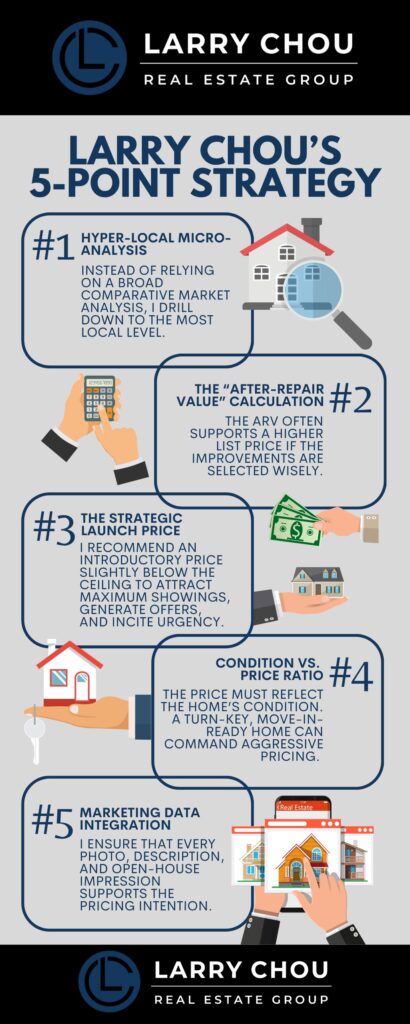In the fast-paced, high-stakes Silicon Valley market, proper pricing is the single most critical factor in selling your home—it’s an art and a science. Price it too high, and your listing languishes. Price it too low, and you leave money on the table.
Done right, pricing becomes the linchpin that turns interest into offers and offers into a bidding war.
That’s where the value of a local, expert guide comes in. Hello, I’m Larry Chou, the Campbell Pricing Specialist.
With deep roots in the Campbell community and a finely tuned understanding of Silicon Valley’s micro-markets, I turn what many sellers assume is guesswork into a deliberate strategy.
I don’t just suggest a number—I craft a pricing plan with every likely buyer, market trend, and property nuance in mind.
This guide explores how a Campbell home pricing specialist maximizes your Campbell home’s value. You’ll see the multi-faceted strategies I use to ensure that your property sells quickly, draws competitive offers, and achieves the highest return possible.

The Critical Cost of Pricing Mistakes
The Danger of Overpricing
Listing your home too high is a trap many sellers fall into. At first, it may attract curious lookers, but over time it sends the wrong message: stagnation.
A listing that sits for weeks or months racks up a high Days on Market (DOM). Buyers begin to wonder, “What’s wrong with this house?”
You may then be forced into a price reduction, often by a larger increment than needed, eroding buyer confidence and handing leverage to the buyer. All of this can result in a final sale price well below your original expectations.
The Danger of Underpricing
On the flip side, underpricing—while sometimes exciting—can be equally costly. The idea is that you’ll spark a bidding war and drive the sale upward. But set the entry price too low, and you risk achieving less than your property’s true worth.
A skilled Campbell home valuation consultant avoids this by positioning just below “ceiling” price zones while ensuring potential buyers see the value. That balance allows for aggressive offers without shortchanging the seller.
The Campbell Context
In Campbell, the market dynamics demand precision. Buyers here are sophisticated—they watch recent closings, scrutinize school-zone boundaries, and compare sales within very small radius bands (often neighborhood block-by-block).
In such a micro-market, even a “small” pricing error (say, $50,000) can mean losing dozens of potential bidders. In short, in a community with discerning, data-driven buyers, an accurate initial price is non-negotiable.

The Pricing Specialist’s 5-Point Strategy
Below are the five critical strategies I apply when pricing a home to sell to transform a guess into a calibrated, competitive price.
Hyper-Local Micro-Analysis
Instead of relying on a broad CMA (Comparative Market Analysis) spanning multiple zip codes or school districts, I drill down to the most local level.
I examine sales data within a two- or three-block radius, factoring in street appeal, lot line variations, and even differences in home orientation (sunlight, yard placement).
That yields the true “price floor” (lowest credible value) and “price ceiling” (top expected outcome) for that micro-segment.
My local familiarity means I know that a home three streets closer to the Los Gatos Creek Trail or within a coveted school boundary is worth tens of thousands more than a similar house just outside that buffer. I map these subtle gradients into the pricing model.
The “After-Repair Value” (ARV) Calculation
Many sellers—and many agents—stick to current-condition value. But buyers respond to vision. I use an After-Repair Value approach: what will this house be worth after modest repairs, updates, and staging.
The ARV often supports a higher list price if the improvements are selected wisely.
I identify the improvements with the highest ROI: fresh, neutral paint, modern lighting, decluttering, minor bathroom refreshes, and smart landscaping.
I quantify what each update adds in buyer perception (not just cost) and integrate them into the final valuation, justifying a stronger list price.

The Strategic Launch Price
Instead of listing at or near the maximum, I often recommend an introductory price slightly below that ceiling. The goal is to attract maximum showings, generate offers, and incite urgency.
High interest in the opening weekend usually leads to multiple offers and upward price feedback.
Because I time the listing launch, stage for high impact, and preview it to likely buyers, I can convert that early traffic into active offers—driving the final sale price above the original list. I’m not banking on luck; I engineer competition.
Condition vs. Price Ratio
The price must transparently reflect the home’s condition. A turn-key, move-in-ready home can command aggressive pricing.
A property that needs updates or repairs must be positioned more conservatively—or target an investor audience. The listing language, photos, disclosures, and showings should all align with this ratio.
When minor condition issues exist, I often negotiate terms (flexible closing, rent-back, seller credits) to ease buyer hesitation—thereby preserving price strength. I frame tradeoffs so buyers feel they’re getting convenience rather than a discount.

Marketing Data Integration
Pricing and marketing speak the same language. If the price is targeting mid-level buyers, marketing highlights affordability, “move-in ready,” and future upside. If the target is luxury or premium buyers, marketing emphasizes quality upgrades, architectural details, and exclusivity.
The listing visuals, narrative, floor plans and staging must reinforce the pricing shape. I ensure that every photo, description, and open-house impression supports the pricing intention.
For example, when the price aims toward the upper tier, I showcase designer finishes; when aiming for a value buyer, I highlight functionality and upside. The alignment builds buyer confidence that the price isn’t arbitrary—it’s deliberate.
Conclusion
At the heart of my approach are three pillars: hyper-local micro-analysis (mapping the true price ceiling and floor), strategic launch pricing (sparking competition rather than stagnation), and ARV focus (factoring in improvements and presentation).
When combined with condition alignment and marketing integration, they form a consistent, data-driven pricing machine.
Don’t guess on your biggest asset. Give me a call today at (408) 759-1201 for a confidential pricing strategy session.
Frequently Asked Questions
What does a Pricing Specialist do differently than a regular Realtor?
A Pricing Specialist digs deeper than standard comparative metrics. Rather than applying broad formulas, I calibrate for micro-neighborhood trends, buyer psychology, condition nuances, and marketing alignment. The result: more precise price positioning, fewer wasted showings, and a greater chance of competitive offers.
How much higher can an expert price a home compared to an average listing?
While outcomes vary, a well-priced home under specialist guidance can often fetch 3 % to 7 % more than a “typical” listing—especially when multiple offers or bidding pressure come into play. In high-demand markets like Campbell, that difference can easily reach tens of thousands of dollars.
Is it better to overprice or underprice my home in Silicon Valley?
Neither is safe. Overpricing can lead to stigma and forced reductions. Underpricing can lead to leaving value on the table. The sweet spot is launching just below peak value to attract strong demand while still preserving upside. A specialist knows just how close to tread that line.
Who is Larry Chou, and what experience does he have in Campbell?
Larry Chou is the Campbell Pricing Specialist—a real estate professional immersed in Campbell and its surrounding neighborhoods. My experience includes dozens of successful sales, in-depth knowledge of school zones, local infrastructure projects, and a reputation for orchestrating winning pricing strategies. (For full credentials, you’re welcome to schedule a conversation.)
What home improvements offer the best return on investment (ROI)?
In my experience, the top ROI improvements tend to be: neutral paint and high-quality finishes, updated lighting fixtures, modern hardware, decluttering and staging, minor kitchen or bathroom refreshes (rather than full remodels), and front-yard landscaping that boosts curb appeal.
How long does it take for a Pricing Specialist to determine the value of my home?
Typically, a full pricing assessment—micro-analysis, ARV modeling, condition audit, and strategy proposal—can be completed in one to three business days. If there’s competition or urgency, I speed up the process without sacrificing precision.



